A backup routine should be part of every Mac user’s life. If you choose the right Mac app and set it up thoughtfully, it shouldn’t be a burden. One day it might become a source of great relief.
Some Mac backup apps are great at helping you get back a lost file or folder. We found that Apple’s Time Machine is the best option here. It comes preinstalled for free on your Mac, runs in the background 24-7, and makes it easy to get back anything you’ve lost.
Other apps create a bootable duplicate of your hard drive. They get you back up and running ASAP if your computer dies or is stolen, your hard drive becomes corrupt, or you purchase a new computer. Carbon Copy Cloner is an excellent choice here and will get you back up and running in no time.
These aren’t your only options, so we’ll cover a range of other alternatives, and help you come up with a backup system that’s both convenient and reliable.
Table of Contents
- Why Trust Me for This Review
- Should You Back up Your Mac?
- Best for Incremental File Backups: Time Machine
- Best for Hard Drive Cloning: Carbon Copy Cloner
- Other Good Paid Mac Backup Software
- Some Free Alternatives
- How We Tested and Picked These Mac Backup Apps
- Tips You Should Know About Mac Backups
- Final Words
Why Trust Me for This Review
My name is Adrian Try, and I’ve been using and abusing computers for decades. I’ve used quite a variety of backup apps and strategies, and I’ve suffered a few disasters as well. As a tech support guy, I’ve come across dozens of people whose computers died without having a backup. They lost everything. Learn from their mistake!
Over the decades I’ve backed up onto floppy disks, Zip drives, CDs, DVDs, external hard drives, and network drives. I’ve used PC Backup for DOS, Cobian Backup for Windows and Time Machine for Mac. I’ve used command line solutions using DOS’s xcopy and Linux’s rsync, and Clonezilla, a bootable Linux CD capable of cloning hard drives. But despite all of this, things have still gone wrong, and I’ve lost data. Here are a couple of stories.
On the day my second child was born, I came home from the hospital to discover that our house had been broken into, and our computers stolen. The excitement of the day vanished instantly. Fortunately, I had backed up my computer the previous day, and left the tall pile of floppies on my desk, right next to my laptop. That was too convenient for the thieves, who took my backup as well—a good example of why it’s good to keep your backups in a different location.
Many years later, my teenage son asked to borrow my wife’s spare USB hard drive. The first thing he did was format it, without even glancing at the contents first. Unfortunately, he picked up my backup hard drive by mistake, and I lost the lot again. I discovered clearly labeling your backup drives is a very good idea.
These days Time Machine constantly backs up anything I change to an external hard drive. In addition, most of my files are also stored online and on multiple devices. That’s a lot of very valuable redundancy. It’s been quite a while since I’ve lost anything important.
Should You Back up Your Mac?
All Mac users should back up their Mac machines. All sorts of things can happen that result in data loss. No one is immune, so you should be prepared.
What could possibly go wrong?
- You could delete the wrong file or format the wrong drive.
- You could modify an important document, and decide that you prefer it the way it was.
- Some of your files could become corrupt due to a hard drive or file system problem.
- Your computer or hard drive could suddenly and unexpectedly die.
- You could drop your laptop. I’ve laughed at a few YouTube videos of laptops being dropped in the ocean or being left on the roof of a car.
- Your computer could be stolen. It happened to me. I never got it back.
- Your building could burn down. Smoke, fire and sprinklers are not healthy for computers.
- You could be attacked by a virus or hacker.
Sorry if that sounds negative. I hope none of those things ever happen to you, but I can’t guarantee it. So it’s best to prepare for the worst. I once met a lady whose computer crashed the day before her major university assignment was due and lost everything. Don’t let that happen to you.
Best for Incremental File Backups: Time Machine
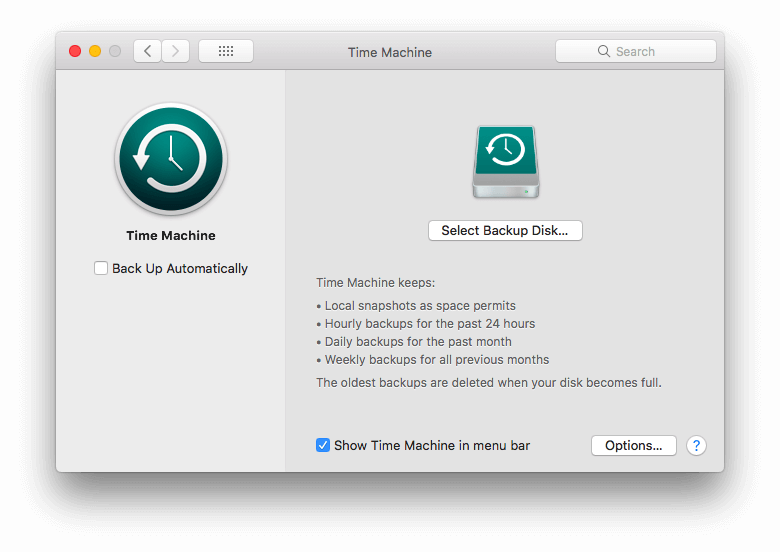
Many people don’t back up their computers because it can be difficult and a little technical to set up, and in the busyness of life, people just don’t get around to doing it. Apple’s Time Machine was designed to change all of that. It’s built into the operating system, easy to set up, and works in the background 24-7, so you don’t have to remember to do it.
Time Machine was originally designed to work with Apple’s Time Capsule hardware, which, along with their Airport routers is being discontinued. But the Time Machine software will continue to be supported and works with other hard drives. It should remain an excellent backup option for years to come.
Time Machine is included free with macOS and back up your files and folders to a hard drive connected to your computer or on your network. It’s convenient, uses a local hard drive, and constantly backs up your files as they change or are created, so you’ll lose very little (probably nothing) when disaster hits. And importantly, restoring individual files and folders is easy.
The app is very easy to set up. When you first connect a blank hard drive, you may be asked if you’d like to use the drive to back up your computer. Alternatively, click on the Time Machine icon at the left of your menu bar, and select Open Time Machine Preferences.
Once you have set up the software, Time Machine keeps:
- Local snapshots as space permits,
- Hourly backups for the last 24 hours,
- Daily backups for the past month,
- Weekly backups for all previous months.
So there’s a lot of redundancy there. Although it uses more storage space, it’s a good thing. If you’ve just discovered something went wrong with one of your files months ago, there’s a good chance you’ll still have an older good copy still backed up.
I back up my 1TB internal hard drive (which is currently half full) to an external 2TB drive. 1TB isn’t enough, because there will be multiple copies of each file. I’m currently using 1.25TB of my backup drive.
Restoring a file or folder is quick and easy. Select Enter Time Machine from the menu bar icon.
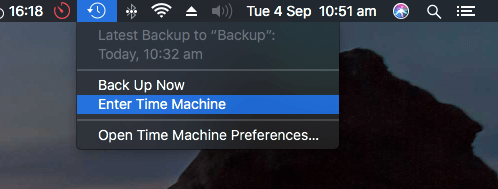
Helpfully, the Time Machine interface looks just like Finder, with previous versions of your folder going off into the background.
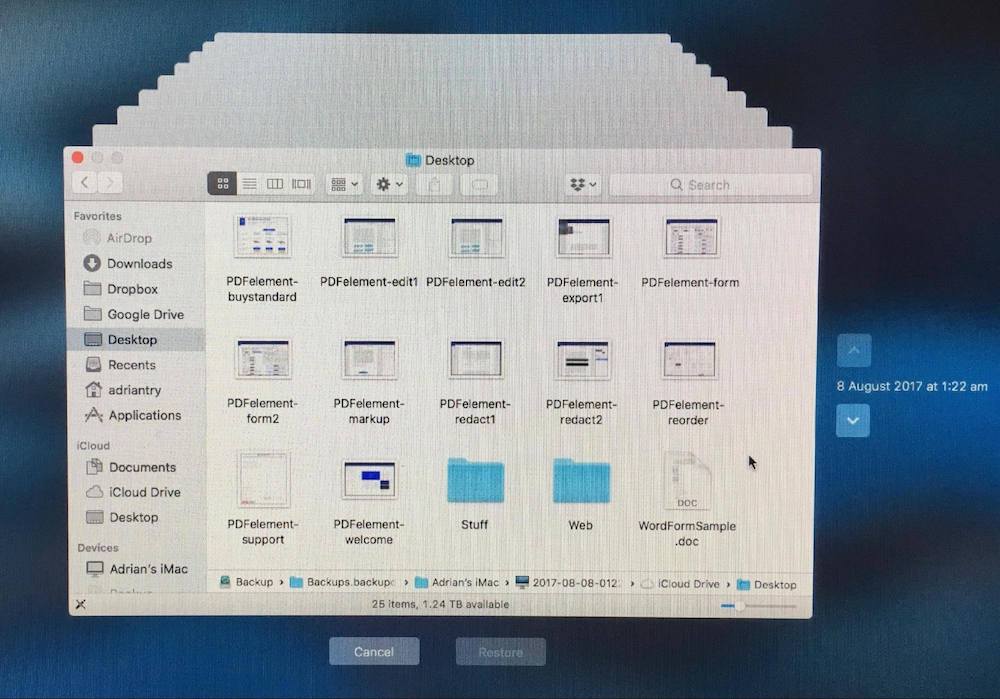
You can move back through time by clicking on the title bars of the windows in the background, the buttons on the right, or the calendar on the far right.

When you find the file you’re after, you can have a look at it, get more information, restore it, or copy it. The ability to “quick look” at a file before restoring is useful, so you can make sure it is the desired version of the file you’re looking for.
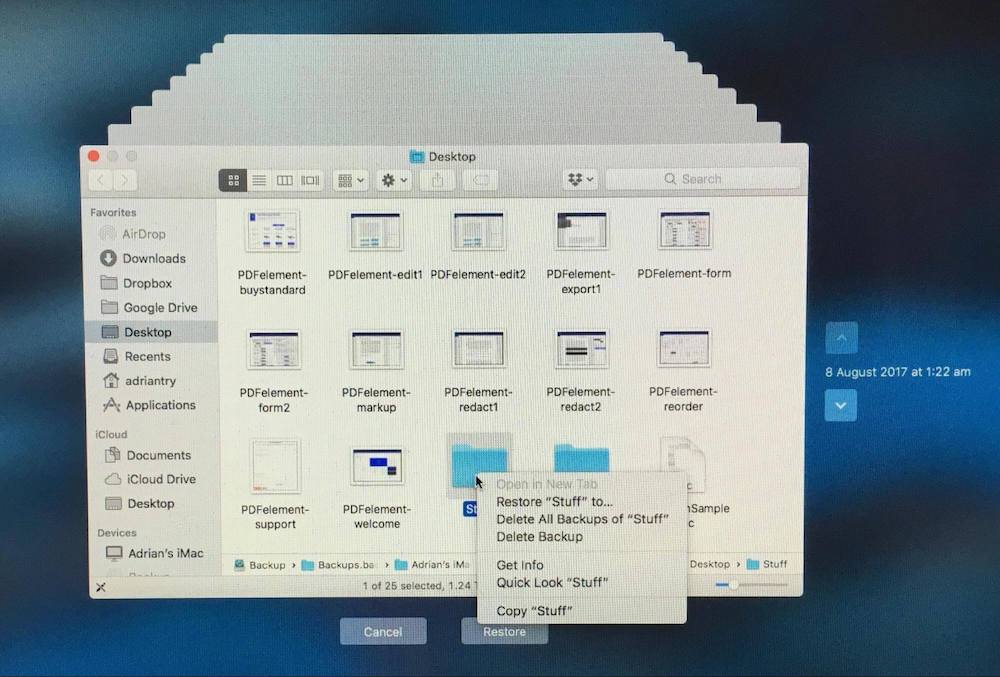
Best for Hard Drive Cloning: Carbon Copy Cloner
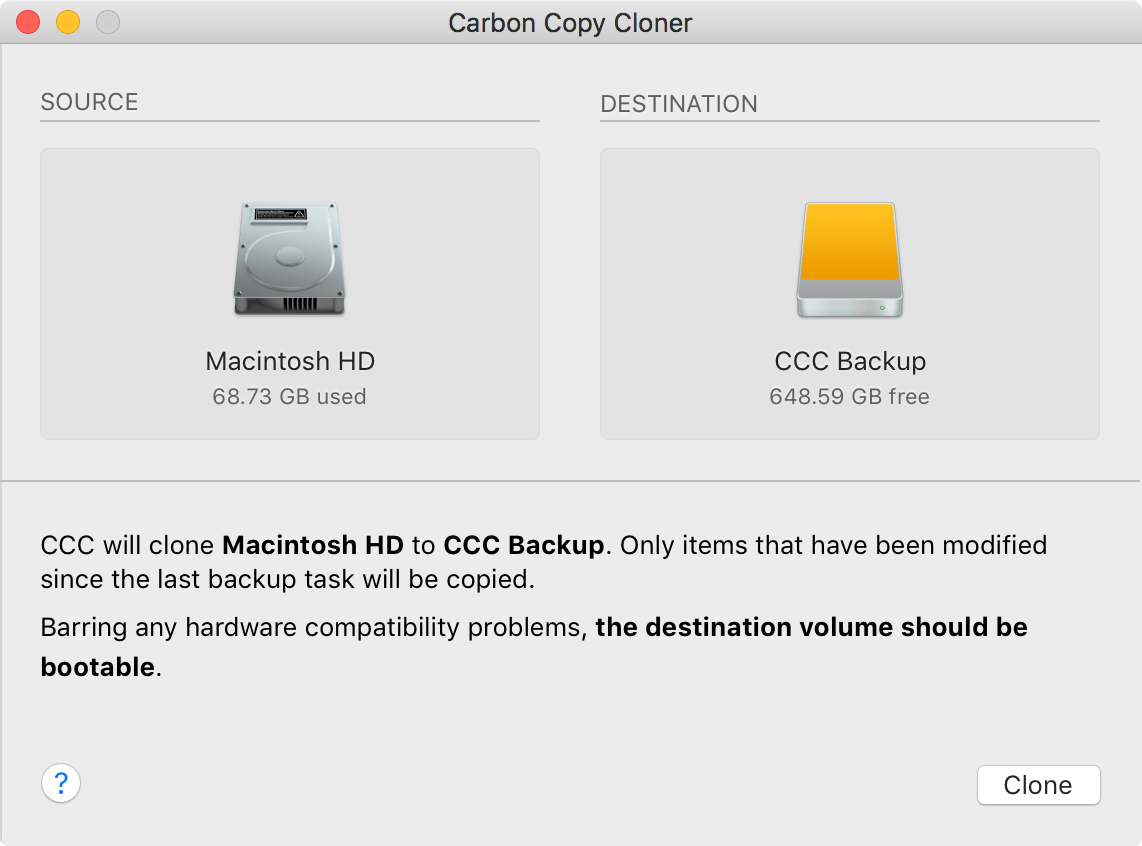
Bombich Software’s Carbon Copy Cloner is a more capable backup app with a more complex interface, though “Simple Mode” is also available, allowing you to back up your drive in three clicks. Significantly, the app allows you to back up your computer in an additional way: by creating an exact clone of your Mac’s hard drive.
Carbon Copy Cloner can create a bootable drive that mirrors your Mac’s internal drive, and then update only the files that have been added or modified. In a disaster, you will be able to start up your computer with this drive and work as normal, then restore your files onto a new drive once you purchase one.
A Personal & Household license is $39.99 from the developer’s website (one-time fee), covering all computers in the household. Corporate purchasing is also available, starting at the same price per computer. A 30-day trial is available.
Where Time Machine is great at restoring files and folders that have vanished or gone wrong, Carbon Copy Cloner is the app you want when you have to restore your entire drive, say when you’ve had to replace your hard drive or SSD due to a failure, or you’ve bought a new Mac. And because your backup is a bootable drive that’s a mirror image of your main drive when disaster hits and your main drive fails, all you need to do is reboot your computer from your backup, and you’re up and running.
All of that makes the two apps complementary rather than competitors. In fact, I recommend you use both. You can never have too many backups!
This app has more features than Time Machine, so its interface is more complex. But Bomtich has made their app as intuitive as possible by using four strategies:
- They’ve tweaked the app’s interface to make it as easy to use as possible.
- They’ve provided a “Simple Mode” interface that can perform a backup in three clicks.
- The “Cloning Coach” will alert you to any configuration concerns and concerns about your backup strategy.
- They also offer guided setup and restoration, so that getting back your lost information is as easy as possible.
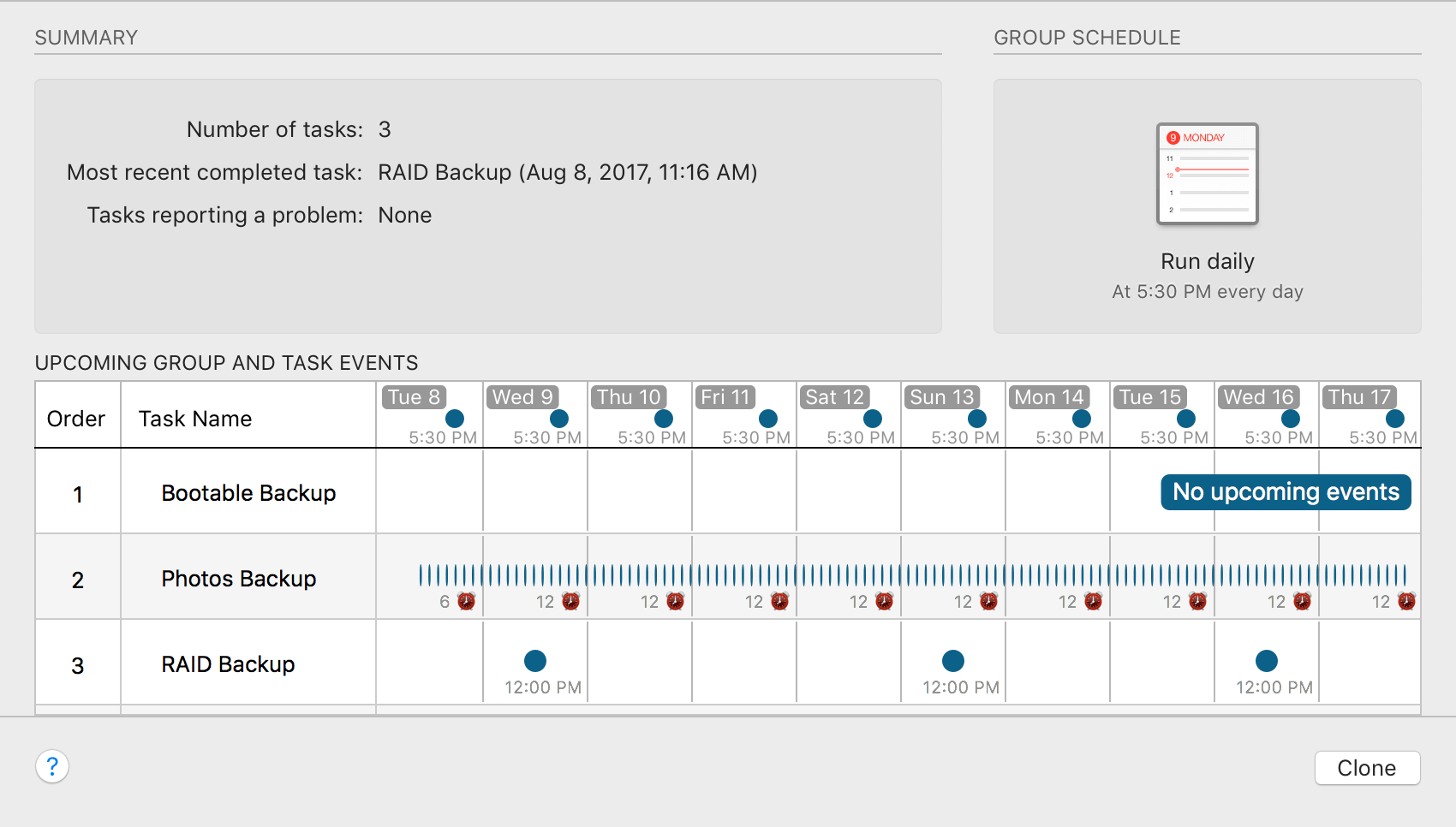
Besides making the interface easy to use, you can automatically keep your backups up-to-date by scheduling them. Carbon Copy Cloner can back up your data hourly, daily, weekly, monthly, and more. You can specify what type of backup is to be done, and chain together groups of scheduled tasks.
Other Good Paid Mac Backup Software
1. SuperDuper! (Bootable Backups)
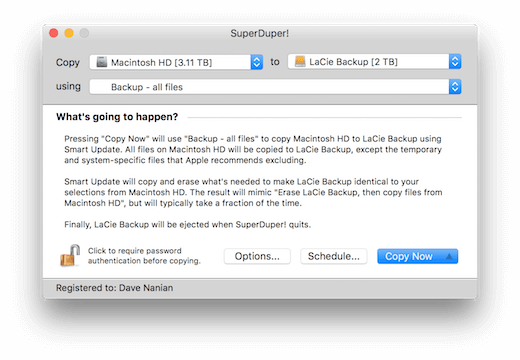
Shirt Pocket’s SuperDuper! v3 is an alternative to Carbon Copy Cloner. It’s a simpler app, where many of the features are free, and the full app is more affordable. SuperDuper! has been around for a healthy 14 years, and although new features have been added, the app looks a little dated.
The interface is very easy to use. Just choose which drive to back up, which drive to clone it onto, and the type of backup you want to perform. Like Carbon Copy Cloner, it will create a fully bootable backup and can update it with just the changes you’ve made since the last backup.
2. ChronoSync (Syncing, File Backup)
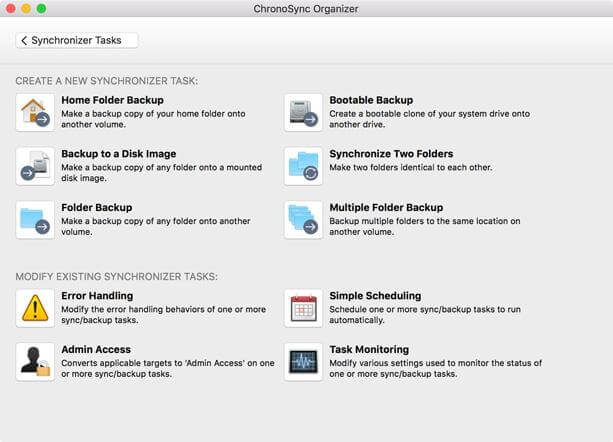
Econ Technologies ChronoSync is a versatile app with many talents. It can synchronize files between your computers, backup your files and folders, and create a bootable clone of your hard drive. This one app can perform every type of backup you need.
Restoring files backed up by ChronoSync can be as easy as browsing for the backed-up file using Finder and copying it, or using the app itself to sync your files back to your hard drive.
You can schedule your backups to take place at a regular time, or whenever you connect a specific hard drive to your computer. It is able to back up only the files that have changed since your last backup and can copy multiple files simultaneously to speed up the operation.
3. Acronis True Image (Disk Cloning)
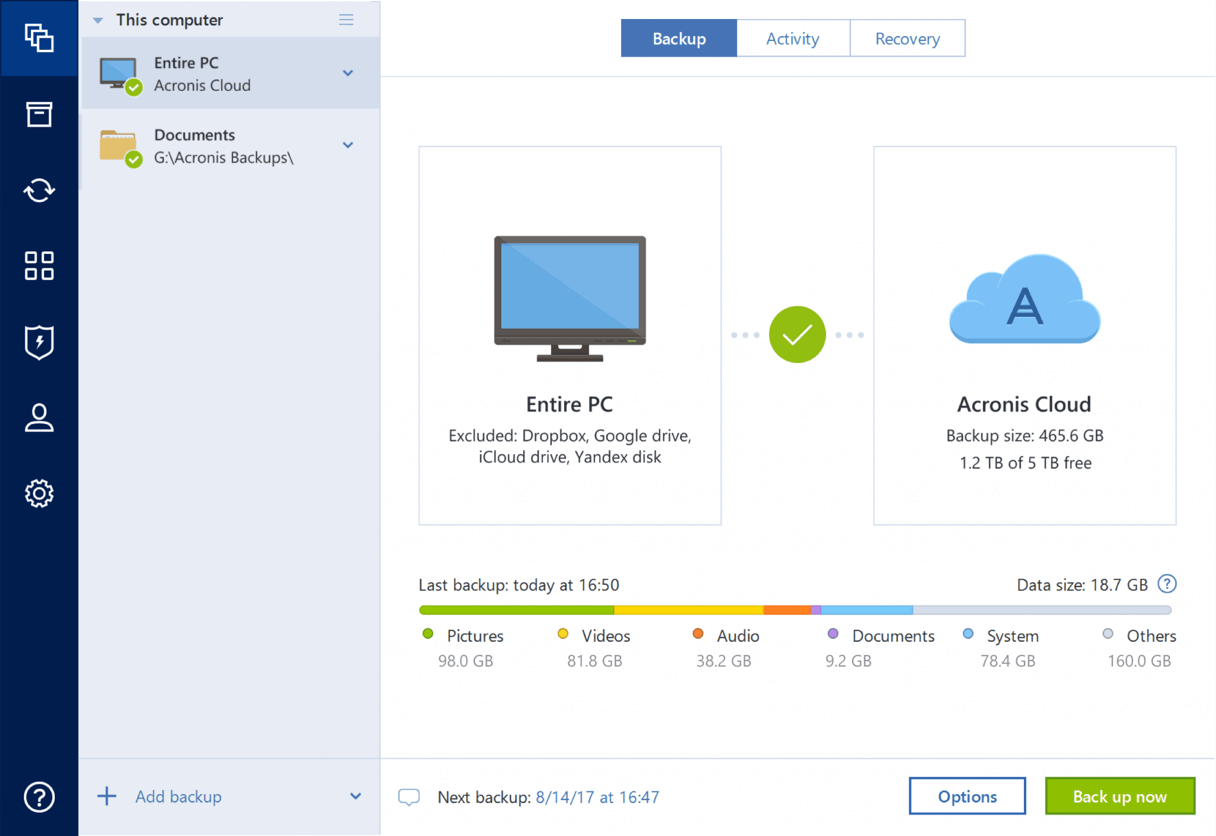
Acronis True Image is another alternative to Carbon Copy Cloner, allowing you to make cloned images of your hard drive. The more expensive plans also include online backup.
Acronis is a little more expensive than Carbon Copy Cloner, and aimed more at corporations than individuals and small businesses. It lacks a personal license that allows you to use the app on all your computers.
You use the app through an intuitive dashboard, and the restore feature allows you to quickly recover your entire drive or just the files you need.
4. Get Backup Pro (Disk Cloning, Folder Sync)
Belight Software’s Get Backup Pro is the most affordable app on our list (not including Apple’s free Time Machine), and it offers you a range of backup types, including incremental and compressed file backups, bootable cloned backups, and folder synchronization. It’s another app that may do everything you need.
Backup and sync can be scheduled, and the app supports external or network drives, as well as CDs or DVDs. Backup templates let you include data from iTunes, Photos, Mail, Contacts, and your Documents folder. You can encrypt your backups for additional security.
The app is easy to use, including when it comes time to restore your files. You’re even able to restore your files onto a computer that doesn’t have the app installed.
$19.99 from the developer’s website, or included in a Setapp subscription. A free trial is available.
Some Free Alternatives
Free Mac Backup Apps
We’ve already mentioned a few free ways to back up your Mac: Apple’s Time Machine comes preinstalled with macOS, and SuperDuper!’s free version is able to do quite a lot. You can also perform a quick and dirty backup using Finder, by dragging your files to an external drive.
Here are a couple of additional free backup apps that you may like to consider:
- FreeFileSync is a free and open-source app that creates backups by syncing your changes to an external drive.
- BackupList+ can create full system clones, regular backups, incremental backups, and disk images can be performed. It’s useful, but not as user-friendly as some of the other apps.
Some cloud backup providers allow you to back up your computer locally with their software for free. We’ll cover those apps in a future review.
Use the Command Line
If you’re more technically inclined, you can bypass apps and use the command line to perform backups. There are some commands that are helpful for doing this, and by placing these in a shell script, you’ll only have to set things up once.
Useful commands include:
- cp, the standard Unix copy command,
- tmutil, which allows you to control Time Machine from the command line,
- ditto, which copies files and folders intelligently from the command line,
- rsync, which can back up what has changed since the last backup, even partial files,
- asr (apply software restore), which allows you to restore your files from the command line,
- hdiutil, which allows you to mount a disk image from the command line.
If you’d like to learn how to use the command line to roll your own backup system, refer to these helpful articles and forum discussions:
- Mac 101: Learn the Power of rsync for Backup, Remote, Archive Systems – Macsales
- Backup to external HDD with terminal commands – Stack Overflow
- Control Time Machine from the command line – Macworld
- Make Back Ups from the Command Line in Mac OS X with These 4 Tricks – OSXDaily
How We Tested and Picked These Mac Backup Apps
1. What types of backup can the app create?
Does the app backup your files and folders, or create a clone of your hard drive? We include apps that can perform both types of backup, and some can do both. In this roundup, we won’t include apps that back up to the cloud—those apps deserve their own review.
2. What types of media can it back up to?
Can the app back up to external hard drives or network-attached storage? CDs and DVDs are slower and offer less storage than these, so are rarely used today. Spinning drives are larger and less expensive than SSDs, so are a good medium for backup.
3. How easy is the software to set up and use?
Creating a backup system is initially a big job, so apps that make setup easy score extra points. Then implementing your backup strategy takes diligence, so apps that offer a choice between automatic, scheduled, and manual backups can make your life much easier.
Backups can be time-consuming, so it’s helpful not to have to back up all of your files each time. Apps that offer incremental backups can save you hours.
And finally, some apps offer sequential backups. These are multiple dated backup copies, so you are not overwriting a good file on your backup disk with one that has just become corrupt. That way you’re more likely to have an uncorrupt version on one of your drives.
4. How easy is it to restore your data using the app?
The whole point of all of these backups is to recover your files if something ever goes wrong. How easy does the app make it to do this? It’s good to experiment and find this out in advance. Create a test file, delete it, and try to restore it.
5. How much does the backup software cost?
Backup is an investment in the value of your data, and worth paying for. It’s a type of insurance that will minimize the inconvenience you’ll suffer if (or when) something goes wrong.
Mac backup software cover a range of prices, from free to $50 or more:
- Apple Time Machine, free
- Get Backup Pro, $19.99
- SuperDuper!, free, or $27.95 for all features
- Carbon Copy Cloner, $39.99
- Acronis True Image, $49.99
Above is what the apps we recommend cost, sorted from cheapest to most expensive.
Tips You Should Know About Mac Backups
1. Back Up Regularly
How often should you back up your Mac? Well, how much work are you comfortable losing? A week? A day? An hour? How much do you value your time? How much do you hate doing your work twice?
It’s good practice to back up your files daily, and even more often if you’re working on a critical project. On my iMac, Time Machine is constantly backing up behind the scenes, so as soon as I create or modify a document, it’s copied to an external hard drive.
2. Types of Backup
Not all Mac backup software works in the same way, and there are several strategies used to make a second copy of your data.
A local backup copies your files and folders to an external hard drive plugged into your computer or somewhere on your network. If you lose a file or folder, you can restore it quickly. Backing up all of your files on a regular basis is time-consuming, so you may want to copy just the files that have changed since you last backed up. That’s known as an incremental backup.
A bootable clone, or disk image, creates an exact duplicate of your hard drive, including your operating system and software. If your hard drive fails, you can boot directly from your backup hard drive and get straight back to work.
A cloud backup is like a local backup, but your files are stored online rather than on a local hard drive. That way, if your computer is taken out by fire, flood or theft, your backup will still be available. Your initial backup may take days or weeks to complete, and you’ll need to pay an ongoing fee for the storage, but they are worthwhile.
3. Offsite Backup is Crucial
Some disasters that can take out your Mac may also take out your backup. That includes natural disasters like fire and flood, and as I discovered, theft.
When I worked in a bank’s data center in the 80s, we’d fill suitcases with dozens of tape backups, and carry them to the next branch where we stored them in a fireproof safe. The suitcases were heavy, and it was hard work. These days, offsite backup is much easier.
One option is cloud backup. Another option is to use several hard drives for your disk images and store one at a different location.
4. Syncing Your Files is Helpful, but Not True Backup
Now that most of us use multiple devices—desktops, laptops, smartphones, and tablets—many of our documents are synchronized between those devices via the cloud. I personally use iCloud, Dropbox, Google Drive, and more.
That makes me feel more secure and is helpful. If I drop my phone into the ocean, all of my files will magically reappear on my new one. But syncing services are not true backups.
One major problem is that if you delete or change a file on one device, the file will be deleted or changed on all of your devices. While some syncing services allow you to return to a previous version of a document, it’s best to use a comprehensive backup strategy as well.
5. A Good Backup Strategy Involves Several Backup Types
A thorough Mac backup strategy will involve performing some backups using different methods, and possibly different apps. At a minimum, I recommend you keep a local backup of your files, a clone of your drive, and some sort of offsite backup, either online or by storing an external hard drive at a different address.
Final Words
We keep a lot of valuable information on our computers: irreplaceable photos, videos of our children’s first steps, important documents we slaved over for hours, and maybe the beginnings of our first novel. The trouble is that computers can fail. Always unexpectedly, and sometimes spectacularly. Your valuable files can vanish in an instant. That’s why you need backup copies of everything.

what is the best app to backup 2.6T of mov, jpg, xls, doc, pdf files which are now on an external hard drive connected to my MacBook Pro to a backup external disk drive. Per Apple tech support, Time Machine will not allow you to back up user files from a connected external hard drive to another connected external backup hard drive. This is very important to me, as apparently these files are not being backed up now. (I thought Time Machine was backing them up). Please respond.
Hi Adrian,
Thank you for this very good article.
I have a quick question.
Can I use both Carbon Copy Cloner and Time Machine on the same external hard drive?
Should I partition the hard drive to use both applications?
Many thanks for the clarification.
Best,
Christophe
In April of 2029 I purchased Acronis True Image 2019, and have been running incrementals ever since. HOWEVER, when I wanted to recover a file from November of 2019, I was unable to do so.
This is because Acronis will only retain 20 backups at a time. There’s no message about this. Instead it’s a menu choice under “Cleanup”.
I spent $27 to purchase a Pay-Per-Incident support “key” in order to find this out.
I want everyone within reach of this page that while Acronis is an OK solution it’s a TERRIBLE decision to limit the amount of backups that are available for recovery. In the real world, we backup until the backup volume
is consumed and then we issue a message to the user informing him of the storage constraint.
Not being able to keep incremental backups for as long as you like is BAD ENGINEERING. It is contrary to the central, core principles of backup software.
If Genie Backup made a Mac solution, I’d be headed there right now, as I have had a positive experience with Genie on the Wintel side.
Please consider adding a portion of this note to your discussion of backup solutions. For the pros out there – guys like me, Acronis isn’t the best choice. There may be no solution for us.
Like many people, I’ve replaced my old smaller capacity drive with a new larger capacity drive as they’ve became available. Mostly to get more storage.
Here’s what I do not know, in CCC vs Time Machine, as far as a back up. I am a music professional. I have tons of music software, and a lot of it obviously requires serial numbers for authorization. Whenever I’ve used CCC to clone a drive, all the music software for the most part worked again flawlessly without asking me to re-authorize. That is a godsend. When I used Time Machine a couple years ago. All of my music software needed to be re-authorized.
I get that all companies would want you to have to re-authorize to prevent others from cloning your drive to use software they don’t have authorization for. In truth who would do such a thing. That means the new person would also have access to other files you certainly don’t want them to have. So I would consider that rare. That makes me appreciate CCC immensely. I cannot even contemplate how many drives I CCC’d simply to upgrade. Trashed to the old drive. Booted up my computer with the new drive and picked up right where I left off as if I never changed drives. I cannot express my gratitude to the makers of CCC enough for such great GREAT software. Even at my job where I’ve had to upgrade drives many many times, CCC made it a simple task and the computers would pick right back up like I said. CCC is masterpiece software.
In closing, I haven’t used Time Machine in quite some time, but I would like to believe it would do the same thing as CCC minus the system back up. Like if I were to buy a new laptop, I would love for Time Machine to migrant my old laptop to the new one flawlessly without requiring me to re-authorize my software. That would be wonderful as well. I think when using CCC to transfer it wants to overwrite everything. Not just clone your old files to the new Mac.
Hi Adrian,
A comprehensive write-up and comparison, thanks. My background is primarily in virtualization and using Windows to access so when my mother-in-law, a retired traveling photographer, approached me with revamping her backup solution for her Mac(s), I could only speak to theory, not products available. She was reviewing Super-Duper, but to me, that looks more like an image-level recovery and might not be great for version control. Ease-of-use is key of course. She benefited from Time Machine a few years ago with a full recovery but it took time after getting the new HDD inserted.
In your your musings, I didn’t see explicit advice on writing to multiple external devices. It appears Time Machine supports this. For instance, she would like to focus on the photographs for her primary MacBook Pro (HSierra). I saw the word “Both” listed in Time Machine. Does that mean you need have two HDDs (or more) attached or can they be rotated? Ultimately, in my opinion, was to have a NAS sitting at home, RAIDed, that could be the primary recipient of the first backup, then that device would write off to some SATA2s which could be maintained offsite, rotated. This may be a bit outside budget. Do you think Time Machine and two external HDDs would be adequate for most prosumer users?
A very useful survey of the alternatives to Mac Time Machine. One factor you do not mention is speed. No one wants a backup system which takes ages to backup or restore. When is your review of online backup and restore sites coming out? I look forward to reading it. But I am naturally nervous (as a lawyer) about trusting my data to anyone who potentially could either lose or misuse it.
In the bad old days of ms dos I was using Acronis True Image. But just look at the price for it now! Software publishers seem to think that because Apple customers have paid a substantial premium to buy a mac over a windows computer they can price gouge them for the software too.
Regards
James
Good summary. I have CCC, but I’m giving up on it. The app keeps losing my registration info and then it prompts me to purchase it again. Locating and reinstalling my registration number is nightmare. At least for me. Looking for a good replacement for CCC.
Thanks.
G’Day Adrian;
Cheers for the article, being 3.00AM I skimmed through it and maybe my question was in there somewhere. So I wish to jump from El Capitan to Mojave in one jump. Found CCC but when going through the procedure you need Disk Utility to erase the target storage. I wish to back up my entire OS El Capitan in case things go south! My Macbook Pro being early 2015, El Capitan 10.11.6
So my question is: Can I use my portable backup drive and not erase my back up files such as video and photo’s? Or do I need another dedicated portable hardrive for CCC?
Cheers Bob